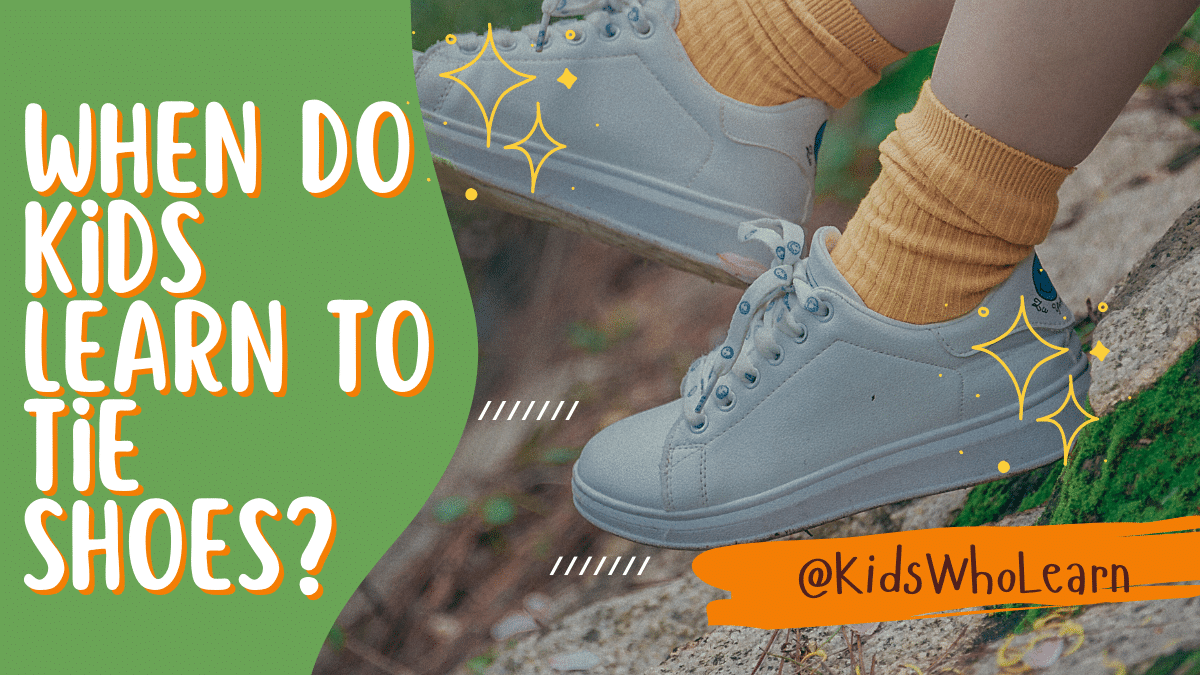If you’re a parent or caregiver of a young child, you might be wondering when they’ll be able to tie their own shoes. Shoe-tying is a skill that requires fine motor coordination and dexterity, which can take time to develop. In this article, we’ll explore when kids typically learn to tie their shoes, as well as some factors that can influence their ability to do so.
Understanding Child Development
Before we dive into when kids learn to tie their shoes, it’s important to understand a bit about child development. Children develop at different rates, and there is a wide range of what is considered “normal” when it comes to milestones like walking, talking, and learning to tie shoes. That said, there are some general guidelines that can be helpful in understanding what to expect.
When Do Kids Typically Learn to Tie Shoes?
Most children will begin to show an interest in learning to tie their shoes around age 4 or 5, and many will have mastered the skill by age 6 or 7. However, some children may not be able to tie their shoes until they are older. It’s important to remember that every child is different, and some may need more time and practice than others.
Understanding Child Development
When it comes to learning how to tie shoes, it’s important to understand child development. This will help you know what to expect and how to support your child’s learning process.
Motor Skills Development
Motor skills development refers to a child’s ability to control their body movements. This includes both gross motor skills, such as running and jumping, and fine motor skills, such as tying shoes.
Young children typically have limited fine motor skills, which means they may struggle with tasks that require precise hand movements. However, as they grow and develop, their fine motor skills improve. By the age of 5 or 6, most children have the physical dexterity needed to tie their own shoes.
Cognitive Skills Development
Cognitive skills development refers to a child’s ability to think, reason, and solve problems. These skills are essential for learning how to tie shoes, as the process involves a series of steps that must be followed in a specific order.
Children typically begin to develop these cognitive skills around the age of 3 or 4. At this age, they may be able to follow simple instructions and understand cause-and-effect relationships. By the age of 5 or 6, most children have the cognitive skills needed to tie their own shoes.
In summary, learning how to tie shoes requires both fine motor skills and cognitive skills. Most children develop these skills by the age of 5 or 6, but every child is different. By understanding child development and providing support and encouragement, you can help your child master this important life skill.
When Do Kids Typically Learn to Tie Shoes
Learning to tie shoes is an essential skill for kids to master as it can help them become more independent and self-sufficient. However, the age at which children learn to tie their shoes can vary greatly. Here are some general guidelines on when kids typically learn to tie shoes.
Early Learners
Some children begin to show an interest in tying their shoes as early as three years old. These early learners may have a natural inclination towards fine motor skills and enjoy the challenge of learning new tasks. However, most kids will not be able to tie their shoes until they are a bit older.
Average Learners
Most kids will learn to tie their shoes between the ages of four and six years old. During this time, children are developing their fine motor skills and hand-eye coordination, which are essential for tying shoes. Parents can encourage their children to practice by providing them with shoes that have laces and by showing them how to tie their own shoes.
Late Learners
Some children may not be able to tie their shoes until they are seven or eight years old. This is not necessarily a cause for concern, as each child develops at their own pace. However, if a child is struggling to tie their shoes, it may be helpful to provide them with shoes that have Velcro or slip-on closures until they are ready to learn.
In conclusion, learning to tie shoes is an important milestone for children, but the age at which they learn can vary greatly. By providing children with opportunities to practice and develop their fine motor skills, parents can help their children become more independent and self-sufficient.
Factors Influencing Shoe-Tying Ability
Child’s Interest
The child’s interest is a significant factor in learning to tie shoes. Some children may show interest in tying their shoes at an early age, while others may not be interested until later. If a child is not interested in learning to tie their shoes, it may be helpful to make it a fun activity by incorporating games or rewards.
Parental Guidance
Parental guidance is crucial when it comes to teaching a child to tie their shoes. Parents should be patient and provide step-by-step instructions to their child. It may also be helpful to demonstrate the process by tying your own shoes in front of your child. Additionally, parents can use resources such as books, videos, or online tutorials to help their child learn.
Type of Shoes
The type of shoes a child wears can also influence their ability to tie their shoes. Shoes with laces that are too long or too short can make it difficult for a child to tie their shoes. It is recommended that parents choose shoes with laces that are the appropriate length and thickness for their child’s age and shoe size.
In conclusion, a child’s interest, parental guidance, and type of shoes are all factors that can influence their ability to tie their shoes. With patience and practice, most children will learn to tie their shoes at some point in their development.
Teaching Methods for Shoe-Tying
Teaching your child how to tie their shoes is an important milestone in their development. There are several methods you can use to teach them, but it’s important to find one that works best for your child’s learning style. Here are two popular methods you can try:
Bunny Ears Method
The Bunny Ears method is a popular way to teach children how to tie their shoes. Here’s how it works:
- Make a loop with one of the shoelaces.
- Make another loop with the other shoelace.
- Cross the loops over each other.
- Tuck one of the loops under the other loop.
- Pull the loops tight.
This method is great for children who are visual learners. It’s also easy to remember because it involves making bunny ears.
Loop, Swoop, and Pull Method
The Loop, Swoop, and Pull method is another popular way to teach children how to tie their shoes. Here’s how it works:
- Make a loop with one of the shoelaces.
- Hold the loop with one hand and use the other hand to make a swooping motion with the other shoelace.
- Bring the other shoelace around the loop and hold it with the same hand that’s holding the loop.
- Use the other hand to make another loop with the shoelace you just brought around the loop.
- Tuck the second loop behind the first loop.
- Pull the loops tight.
This method is great for children who are kinesthetic learners. It involves a lot of movement, which can help them remember the steps better.
Whichever method you choose, it’s important to be patient and encouraging with your child. Learning to tie their shoes can be frustrating for them, but with practice and persistence, they’ll get the hang of it in no time.
Encouraging Practice and Patience
Learning to tie shoes can be frustrating for kids, but with practice and patience, they can master this important skill. As a parent or caregiver, there are several ways you can encourage your child to practice tying their shoes.
First, make sure your child has the right tools. Provide them with shoes that have laces that are easy to grip and tie. You can also purchase special lacing cards or boards that allow your child to practice tying without the added pressure of tying their own shoes.
Next, set aside time each day for your child to practice. Start with short sessions, such as five or ten minutes, and gradually increase the time as your child becomes more comfortable with the process. Encourage your child to practice on their own, but be available to offer guidance and support as needed.
It’s important to remain patient and positive throughout the learning process. Avoid getting frustrated or critical if your child struggles to tie their shoes. Instead, offer words of encouragement and praise for their effort and progress.
Finally, consider using visual aids to help your child understand the steps involved in tying shoes. You can use a diagram or video tutorial to demonstrate the process, or create a step-by-step guide that your child can refer to as they practice.
Remember, learning to tie shoes takes time and practice. By providing your child with the right tools, setting aside time for practice, and offering patience and encouragement, you can help them master this important skill.
When to Seek Professional Help
Learning to tie shoes is an important milestone for children. While most children learn to tie their shoes between the ages of 4 and 6, some children may struggle with this skill. If your child is having difficulty learning to tie their shoes, there are a few signs that may indicate it’s time to seek professional help.
Signs that your child may need professional help
- Your child is over the age of 6 and still cannot tie their shoes
- Your child becomes frustrated or upset when attempting to tie their shoes
- Your child has difficulty with other fine motor skills, such as holding a pencil or buttoning their clothes
- Your child has been diagnosed with a developmental delay or disorder, such as autism or ADHD
If you notice any of these signs, it may be time to seek professional help. A pediatric occupational therapist can work with your child to improve their fine motor skills and teach them how to tie their shoes.
How a pediatric occupational therapist can help
A pediatric occupational therapist can provide individualized therapy to help your child improve their fine motor skills. They may use a variety of techniques, such as:
- Hand strengthening exercises
- Hand-eye coordination activities
- Fine motor skill activities, such as using tweezers or scissors
- Visual cues and prompts to help your child remember the steps to tying their shoes
In addition to working with your child, a pediatric occupational therapist can also provide guidance and support to parents. They can offer tips and strategies to help your child practice their skills at home.
Overall, if your child is struggling to learn how to tie their shoes, it’s important to seek professional help. A pediatric occupational therapist can provide the support and guidance your child needs to develop this important skill.
Frequently Asked Questions
At what age do children typically learn to tie their shoes?
Most children learn to tie their shoes between the ages of 4 and 7. However, some children may learn earlier or later than this range.
What are some effective methods for teaching kids to tie their shoes?
There are several effective methods for teaching kids to tie their shoes. Some popular methods include using a shoe-tying song or rhyme, using a shoe-tying board or toy, and breaking down the steps into smaller, more manageable parts.
Is it normal for a 9-year-old to struggle with tying their shoes?
It is not uncommon for a 9-year-old to struggle with tying their shoes. Some children may require more time and practice to master this skill.
How can I help my 11-year-old who still can’t tie their shoes?
You can help your 11-year-old by providing them with additional practice and support. Consider using visual aids, such as diagrams or videos, and breaking down the steps into smaller, more manageable parts.
What are some fun ways to teach a child to tie their shoes?
There are many fun and creative ways to teach a child to tie their shoes. Consider using a shoe-tying game, incorporating a favorite character or toy, or using colorful laces to make the process more engaging.
Should I be concerned if my 7-year-old can’t tie their shoes yet?
It is not uncommon for a 7-year-old to struggle with tying their shoes. However, if you have concerns about your child’s development, it is always a good idea to speak with their pediatrician or a qualified healthcare professional.






